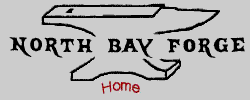Adze Instructions |
| (A copy of this is included with each adze and each adze iron.) |
| Please be very careful when using this tool. It can remove a lot of wood quickly, but it can also cause a great deal of damage. |
| |
Using
The elbow adze is a remarkably versatile carving tool. While capable of very fast and aggressive wood removal,
it is also possible to carve right-to-the-line. If you know where you are going, you can get there incredibly fast with an adze!
If you haven't used an elbow adze before, take your time and go at it slowly. Virtually all the motion should be with your forearm and wrist.
Your elbow should remain almost stationary at your side. You'll quickly get used to the stroke needed to get the right amount of bite.
If you are trying to remove too large a chip, the iron will probably get stuck a lot. On the other hand, if the edge doesn't engage into the wood at all,
then the iron will just bounce off. The edge should be engaging into the wood just enough to start a shaving, continue it, or remove it. |
| |
Sharpening
Touch up the edge frequently by stropping. A flat board (one or two inches wide) with leather glued on it works well for the convex side of the
gutter adzes and for both sides of the straight adzes. A dowel (about 1 inch diameter) with a piece of leather glued onto it works well for the
concave side of gutters. A rouge should be rubbed into the leathers very often, every dozen strokes or so. This will greatly hold off any significant
sharpening.
If more aggressive sharpening needs to be done, it is very important to maintain the correct bevel on the bottom side of the blade
(the side not facing the handle.) Therefore most sharpening should be done on the side of the blade facing the handle. The bottom side should
only be stropped. |
| |
Care
The iron was forged from a round bar of high carbon steel. It will rust very quickly if not taken care of. Vaseline or other oil or grease should be wiped
on the blade after each use.
To keep the edge sharp protect it from contact with other hard surfaces like glass or metal. Only carve clean wood with no embedded abrasive particles
(sand or dirt, for example.)
The handle was given a light coat of tung oil. It will pick up the oils from your hand and should need no further care.
|
|
|
|
|

